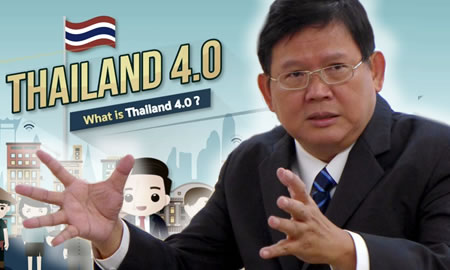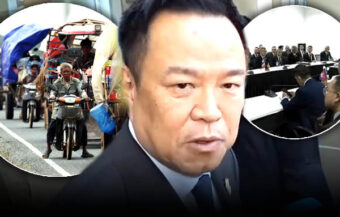Thailand 4.0 is no government PR gimmick or propaganda exercise – it is an honest plan that could transform Thailand
The Thai government plans to transform the kingdom. The name is inspired by the latest industrial revolution as developed world economies target the digital economy, the highest value-added sector, while also upscaling existing industries through technology and robotics. Welcome to Thailand 4.0. Initially brushed off by sceptics as a PR exercise, the current government has shown a dogged determination to implement the plan. Ultimately if successful it could, over decades, spell an end to the idyllic and relaxed lifestyle enjoyed by many foreign retirees as Thailand becomes a high income, high-cost nation. But can it work?

Thailand 4.0 is an economic plan that places emphasis on creativity, innovation, new technology and high-level services. The ultimate aim is to transform Thailand into a value-based economy by developing new sectors that require modern technology and skilled workers such as robotics, digital industry, logistics and the biochemical industry. The plan is also directed at diversifying Thailand’s service sector which relies almost exclusively on tourism, by devoting more resources to other services, such as health care and e-commerce. Turning away from industries that consume a lot of resources and have negative environmental impacts, Thailand 4.0 is predicted to bring about sustainable economic growth as outlined by the Late King Bhumibol Adulyadej’s ‘Sufficiency Economy Philosophy.
What does Thailand 4.0 mean to foreigners?
In many ways, it is not good news for foreigners with a deep love of Thailand’s unique, idiosyncratic and quaint culture and those who live in Thailand because of the low-cost benefits. Perhaps it may good news for foreigners who genuinely love Thai people and wish the country every success. Many foreigners are attracted to Thailand because of its ‘unique culture’, it is often remarked that it is the most different place in the world due to the gap that exists between life in Thailand and anywhere else. For many foreigners, this means the unique Buddhist culture which goes hand in hand with patriotism and nationalism in Thailand. It also underpins what is still a very patriarchal society. While it should be possible to accommodate all that currently represents the best of Thailand and preserve what is unique, indeed even improve it, Thailand 4.0 is certainly a move towards a more modern Thailand, less dependent on tourism and towards creating a more equal society that serves the best interests of Thai citizens.
A recent World Bank report highlighting the environmental cost to Thailand of excessive tourism and Thai authorities have already this year been forced to close off some renowned beaches in order to preserve them as tourist numbers show historic gains driven particularly driven by Chinese visitors.
And end to low-cost Thailand
The low cost of living that is such a boon to foreign retirees and those who enjoys a low cost of living in the land of smiles and sunshine is achieved in Thailand through low labour costs and a lack of development. It’s an unpalatable truth that must be faced.
Thailand 4.0 is, in fact, a wide-ranging plan to change all that by elevating the income and GDP of the Thai population through a higher level of education, upskilling and the creation of an economy that is more broadly based and is able to compete in the merging worldwide digital economy now worth $11.5 trillion and representing 15.5% of world GDP.
Thailand 4.0 – a strategy similar to the personal one of many foreigners who move to Thailand
In many ways, the plan envisages putting the Thai government behind a concerted and detailed programme to do, in a resourced and government-supported way, what many foreigners attempt to do when they seek to utilise the digital economy to generate a western standard of income while living in the relatively low-cost economy of Thailand.
The Thai government’s plan is broader-based and foresees utilising digital technology in developing its existing agricultural and industrial economies while also widening its service industry by reducing its reliance on tourism and focusing on higher-value areas such as advanced health care.
The plans promoters have already identified the main obstacles which the plan faces in order to be successful.
They are many and will be difficult to overcome but it would be wrong to dismiss the blueprint as PR. Thailand 4.0 is based on an honest assessment and is also supported by very practical initiatives. Thailand 4.0 effectively began in 2016 when the Thai government established and put in place the groundwork for a digital economy including a dedicated government department and minister.
The creation of a development corridor in Thailand’s eastern provinces, a digital university, less regulation of foreign workers and investment, more skills training, an upgrade of public IT platforms into one public service portal and greater public investment in digital technology including the promotion of new ventures are all practical first steps. The ultimate goal is education and a new mindset to empower Thai people in the workplace and new Thai digital entrepreneurs to take on the world.
What exactly is Thailand 4.0?
There are some still who view Thailand 4.0 as a fashionable buzz word used by those eager to be seen to be progressive such as the information Y2K in the computer industry at the turn of the millennium.
Many Thai people are always eager to latch onto such expressions often as a shield to hide a lack of confidence or knowledge. Many cynics believe and suggest that Thailand 4.0 is an elaborate PR exercise but they are quite wrong. Thailand 4.0, if implemented, has the potential to change Thailand forever and is a real attempt to address Thailand’s real problems with a practical way forward.
Thailand 4.0 will see Thailand grasping the digital age
A simplistic way to understand Thailand 4.0 is to see Thailand 1.0 as an economy based on agriculture, Thailand 2.0 as an economy based on light industry or assembly operations and Thailand 3.0 as an economy based on heavy engineering.
Thailand today is a country with a unique culture, a huge tourism industry, an agricultural sector and an industrial sector with a development mix between 2.0 and 3.0. It is a country at a crossroads, a country that is, in some ways, quite closed off from the world by its unique and patriotic culture in a world which is in itself at a crossroads.
Thailand 4.0 is an ambitious plan to address this situation despite many unique obstacles that stand in its way. Those who promote the plan also believe that these unique challenges are also linked to the prime drivers of Thailand’s political unrest from 2006 to 2014 namely inequality, an economy with a lack of balance and a society in which many feel disempowered.
Thailand 4.0 – a plan for Thai workers to upgrade incomes through better skills and opportunity
One of the main movers behind Thailand 4.0 and someone who best explains it is Thailand’s Minister for Science and Technology Suvit Maesincee.
In 2016, while Deputy Minister of Commerce, he outlined Thailand 4.0 in a report carried on an Asian business news website Investvine.
Pulling no punches in the reported interview, the minister pointed out that Thailand 4.0 is a plan not just to overcome the often quoted middle-income trap faced by developing economies when development reaches a point where higher value and growth is limited by competition from poorer countries but pointed to Thailand 4.0 as a blueprint to combat Thailand’s ‘inequality trap’ and ‘imbalance trap’.
In other words, the objective of Thailand 4.0 is to give more opportunity to Thai workers and citizens to educate themselves and work themselves into a more affluent and more equal economy and society.
Understanding the ‘middle-income trap’ that Thailand wants to beat and jump over
The Thailand 4.0 plan has often been quoted as an approach to avoid the middle-income trap associated with a lack of industrial development as incomes rise. The average salary for a factory worker in Thailand is $370 while workers in Vietnam and Myanmar earn just half that. Thailand’s GDP per capita for 2018 is projected to be just under $7,000, far lower than developed countries. The problem is that with competition from other low-cost neighbours and problems such a demographics kicking in, Thailand’s ability to move to a high-value economy is limited. In the meantime, Thailand has unique challenges such as a closed-off culture, a low level of English proficiency, corruption, inequality and an imbalance in its economy caused by an over-reliance on tourism. However, it should be noted that tourism is, in fact, only 15% of the Thai economy. That being so, it is an economic sector that continues to outperform and generates hard currency directly benefiting Thai communities. It is still of immeasurable importance to Thailand economically.
Thailand 4.0 foresees a ‘change of engine’ in Thai thinking, skills and attitudes
Thailand’s Minister of Science and Technology has been very critical of Thailand’s inward thinking particular among those who work in Thai government institutions and bureaucracy when he outlines what Thailand 4.0 is about. He has also been highly critical of Thailand’s education system.
Suvit Maesincee explains that there is a ‘huge knowledge gap between Thailand and the developed world’ and that this is holding back the development of the Thai economy and more importantly, innovation, that leads to growth. The minister lambasts the Thai education sector: ‘Our education system is very ineffective and reforms are seriously needed in order to produce more highly skilled talent,’ he is reported a saying.
The minister explains that Thailand must ‘change the engine’ of its economy and indeed society to bring about and cultivate a ‘more global mindset’.
He is firm in the belief that a more balanced society in Thailand can only be brought about by better education. ‘Better education leads to a more balanced society and eventually a better life for its members.’ The minister says Thailand needs to ‘change its engine’ and this is how he explains Thailand 4.0. He suggests that many problems that Thailand is facing including political problems and corruption can be linked to deficiencies in the education system and the lack of a more balanced society. This would include also a better distribution of wealth and therefore less inequality. He stresses that Thailand is not only fighting a ‘middle-income trap’ but also an ‘inequality trap’ and an ‘imbalance trap’.
English language is an advantage to society – Thai minister who promotes Thailand 4.0
The minister claims that English is the universal language and must be harnessed by Thailand as its use confers an informational advantage to society. ‘It gives an informational advantage over those who have to rely exclusively on Thai media. Global news in Thai, especially on economics, is usually reported two days late which causes errors in decision making by those that depend on it,’ he said.
‘We’re too nationalistic’ – Thai Minister explains Thailand 4.0 as a more open society
Mr Maesincee says that Thai people, particularly Thai civil servants, are too nationalistic and that many working in the Thai government have a ‘poor command of English’ which he says they tend to hide by ‘exaggerated’ displays of patriotism. ‘Some still insist that foreigners in Thailand should speak Thai.’ He points out that many officials ignore the fact that only a few people beyond Thailand’s border scan speak Thai.
Thailand’s economy projected to achieve consistent growth as a result of stability
The 4.0 initiative comes about as Thailand’s economic outlook is at its brightest for years. After years of social upheaval, the country has finally enjoyed steadily increasing economic growth, indicating solid recovery, according to the World Bank. Last year’s growth rate was 3.3 per cent, which was higher than market expectations, thanks to increased contributions from merchandise, agriculture and tourism as well as major infrastructure projects. Experts predict that if the Thai government carries out more business-friendly reforms and eliminates structural bottlenecks, yearly growth above 4 per cent will be possible.
Thailand’s 4.0 plans envisage easier visa and work permits for key foreign workers
To aid the Thailand 4.0 plan, Thai authorities in 2017 passed the National Competitive Enhancement Act for targeted industries that provide financial incentives for research, development and innovation. The targeted industries are divided into two groups: Thailand’s traditional strong points that can be value-added by using advanced technology and Thailand’s future growth engines. Among the incentives are corporate tax exemptions and subsidies for firms working in the preferred industries. About 10 billion baht (~USD 286 million) will be invested in those enterprises for innovation or research and development. Besides financial aids, the law also makes the visa and work permit approval process friendlier for foreign experts and skilled workers so that they can come to Thailand to work more easily. This will allow the country to tap a large pool of talent overseas.
Lack of critical skills a major obstacle to Thailand’s ambitious 4.0 development programme
The path to success of Thailand 4.0 is riddled with difficulties. Though Thai people’s levels of education have consistently risen, there is still a lack of qualified workers. A large proportion of the current Thai workforce is not equipped with the necessary skills to succeed in a 4.0 economy, namely English, teamwork and technical knowledge. There is also an urgent need to improve student quality as Thai students aged 15 underperform their peers in Vietnam and Malaysia in PISA tests, according to the OECD.
Thailand’s demographic time bomb is a key negative factor that must be overcome
Another concern for Thailand 4.0 advocates is a lack of interest among Thailand’s broader business sector. About half the companies that took part in a survey conducted by the University of the Thai Chamber of Commerce were unaware of what Thailand 4.0 would ultimately bring about for the country.
There is also the intractable issue of the ageing population.
The speed of ageing in Thailand is among the fastest in the world and the share of the working-age population is in decline, but the social safety net for old people that exists in a developed country such as Japan and South Korea is not yet developed in Thailand.
Inequality in Thailand and funding for the implementation of 4.0
The OECD has also warned Thailand of the rising economic disparities between classes as more wealth is being concentrated in the top 1% of the Thai population.
However, this must be weighed up by looking to the success of the Thai government in reducing poverty from 12.3% in 2011 to 7.2% in 2015.
This is quite an achievement during a period of political turmoil. There are also stark differences between urban and rural areas in terms of job opportunities and economic development. Supporters of the plan argue that the programme is designed to tackle inequality.
Thailand’s wealthy and successful class may be a positive factor to assist Thailand 4.0
There may also some advantages to this in harnessing Thailand’s strong and wealthy business class which can spearhead new initiative and developments. Many of Thailand’s most successful enterprises are family-owned enterprises with a long track record of success. The key to the success of the programme will be the availability of outside investment sources. Thailand has been in the vanguard in recent weeks in an effort to establish an economic fund to support development in South East Asia that is independent of China for major infrastructure and development projects.
World at a crossroads – Thailand also needs to protect its interests in a changing world
It would be foolhardy in 2018 not to face up to the fundamental change in economic policy and challenges that have emerged by a sudden shift of policy from the United States with President Donald’s Trump’s policies and in the UK with Brexit.
Europe and the EU are increasingly being pulled apart by inward-looking, nationalistic politics. Many people in world economic bodies dismiss this trend as ‘irrational’ and ‘counterproductive’ but this may be wrong or at least missing the point. The political movements are a genuine political response from the electorates in developed countries who have lost out through globalisation and economic policies that emphasise GDP growth over equality in society and social harmony.
There is also the issue of national security and indeed national identity which some claim has been ignored and devalued through the drive towards globalisation and increased GDP pursued by the governments of the developed world up to 2015. The migrant crisis in Germany in 2015 was the moment when populist opinion in developed countries shifted and has been moving since to the right. This world change in the economic climate and political opinion will impinge on the Thai government’s plans for better or worse.
Upgrading existing economic sectors – an essential part of Thailand 4.0
The development plan is not solely focused on Thailand’s participation in the world digital marketplace. It is also aimed at introducing ‘smart technology’ into Thailand powerful and extensive farming sector including biotechnology. Thailand’s rapidly expanding manufacturing and engineering sector can be upgraded by harnessing robotics and mechatronics.
All hinges on training Thai people in the practical use of this technology through an improved education system. It also involves providing for the practical training ‘blue collar’ workers transforming them from labourers to skilled workers.
The plan envisages widening Thailand’s service sector, which currently is just an adjunct to the country’s tourism industry. In fact, right now in Thailand, over 70% of service industries are linked to tourism. ‘We clearly need to diversify it,’ says Science and Technology Minister Suvit Maesincee. Thailand 4.0 calls for a broader service sector with the use of advanced technology and supported by more skilled works with a higher command of English.
Many populist policies in western countries are similar to those in Thailand
Ironically, many of these populist policies emerging in western countries espouse values which are an essential part of Thai culture and indeed policies being pursued by the current Thai government such as national security and the strengthening of immigration enforcement. The retrenchment towards the protection of traditional economic sectors from the disruptive forces of new technology and the digital economy is also part of this wider story. The challenges faced by Airbnb and Uber in Thailand are an example of this.
Yet it is possible to work out a middle course.
It is clear that Thailand 4.0 as a policy must also be adapted to make sure that Thailand maintains its security, protects its existing economic interests and does not lose its unique culture and shared social values. It is clear that this what the Thai government has in mind when taking an overarching view of its policies since 2014.
Digital economy opportunities for Thailand
Thailand 4.0 identifies advanced health care as a key area for the development of Thailand’s digital economy. Thailand already has an extensive healthcare industry which attracts visitors from all over the world in the form of health tourism.
It may also be an irony that in order to become less dependant on the tourist industry that tourist visitors to Thailand may be the key to developing a stand-alone digital industry. Success in this area will require ideas, innovation and original thinking. Carefully and cautiously opening up Thailand to talented foreigners and entrepreneurs who invest may be another way forward and already Thailand is making moves to relax employment regulations. This will also require a review of Thailand’s business laws governing foreign ownership companies and investment opportunity for foreign companies.
The improvement of English language skills in Thailand and its wider use is also a key objective. The Thai government in its 4.0 plan has identified ‘fintech’ or online platforms associated with financial services as a key target area. Other growth areas include e-commerce platforms and distribution and cybersecurity.
Thailand has shown itself to be a country with a skill to harness new skills in the past and Thai people are naturally creative. Anyone who doubts this has only to look at the highly impressive Thai advertising industry and computer graphics sector.
Thai government has an impressive track record over decades in steering development
Such enormous challenges lead some to call the ambitious plan a ‘daydream’. One would be wrong however to underestimate the resolve and resourcefulness of Thai people. The Thai government has an impressive record in improving the welfare of the Thai people over the last few decades even without a western-style social welfare system. While a fifth of Thailand’s population lived in extreme poverty in 1980, the 2010 figure was so low as to be zero with overall reductions in poverty continuing to occur. During that time, universal education and health care coverage have also become a reality for many poorer Thai people. Still, admittedly, Thailand has a long way to go before becoming a developed economy.
Thailand 4.0 is an ambitious plan but an honest assessment of where Thailand should be going
Thailand 4.0 is an ambitious programme that will require huge investment and a major shift from an economy now with low-cost manufacturing, agriculture as well as tourism and services at its core to a higher value one with higher incomes and more advanced technology. The changes it will bring in Thailand will be far-reaching and will, of course, have unintended consequences. Ideally, it would be nice if Thailand could retain as much of its unique character and qualities that make it so loved by foreigners. However, the government of Thailand must fight for the best interests of Thai citizens first and foremost.
Thailand 4.0 – will it work?
The plan faces many challenges not least the emerging threats from a world itself at crossroads and facing powerful new forces while in Thailand demographics and inertia will combat the plan trying to force it back and trim into a failed propaganda exercise. There are several things it has going for it.
First, the plan is an honest assessment of Thailand’s problems, second, the digital economy and technology, as well as a more networked global world, is already happening and Thailand is well placed to be part of it. Tourism has brought one thing to Thailand and that is international contacts and brand recognition.
Thailand is seen by many foreigners as a home from home and today, up to 1 million Thai people live around the world. Thailand has a very strong base of entrepreneurs and entrepreneurial flair not least among Thai women and the Thai Chinese community. Lastly but most importantly, the track record of the Thai state in progressing the gradual development of Thailand is quite impressive despite all the ups and downs.
For foreigners interested in Thailand and living in Thailand, it is time to look at Thailand 4.0 as an opportunity. Change is inevitable for the progress of any nation so why not embrace it or at the very least, prepare for it?
Join the Thai News forum, follow Thai Examiner on Facebook here
Receive all our stories as they come out on Telegram here
Follow Thai Examiner here
Further reading:
Thailand’s new move to boost the birth rate and fight the negative impact of an ageing population
Denmark and Thailand seek economic partnership and face the same challenge – demographics
Thailand’s new move to boost the birth rate and fight the negative impact of an ageing population
BCG economic and social blueprint over the next 5 years unveiled, promises more money for less
Noble spirit of Thailand’s elderly helps country deal with demographic problem
Thailand to launch a moon space programme to boost efforts to become a high-income economy
Finance Minister says economy must pivot away from tourism with a switch to S-Curve industries


















